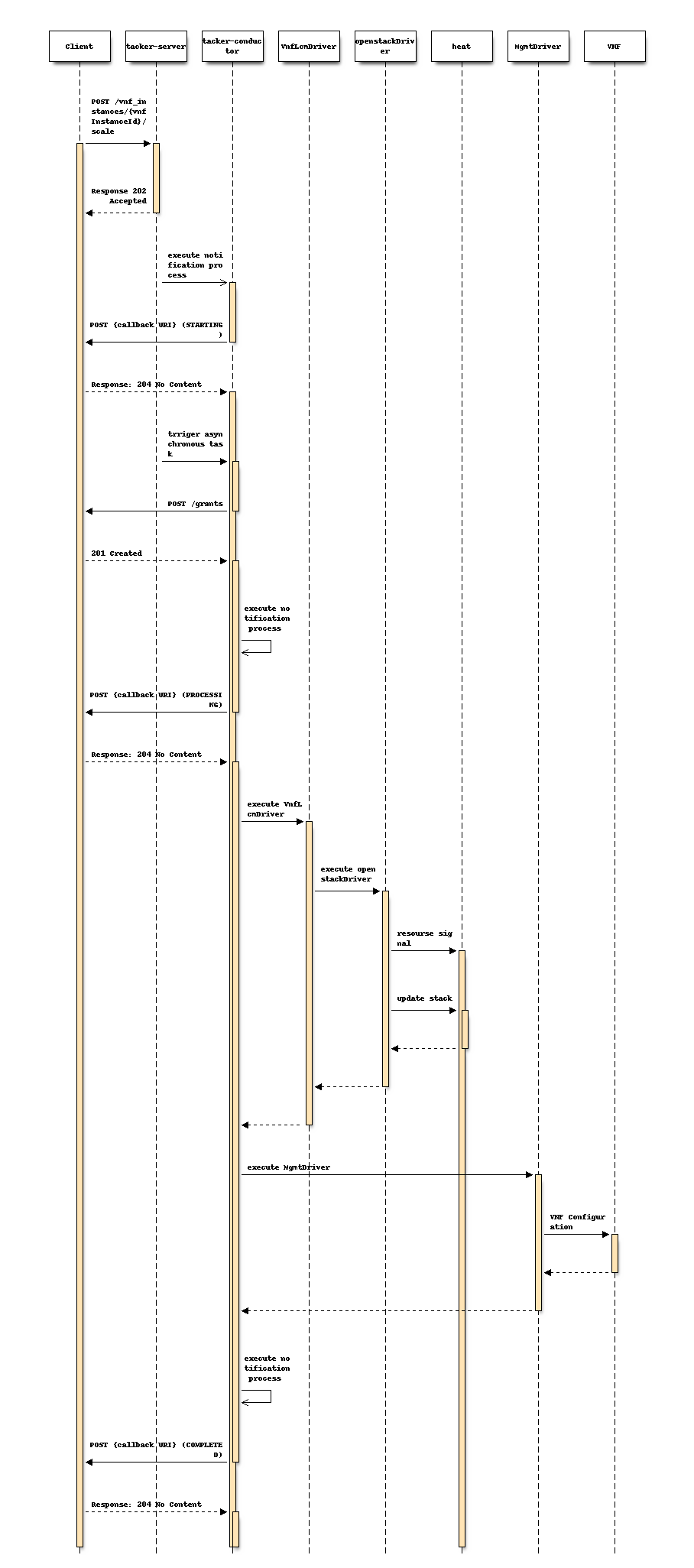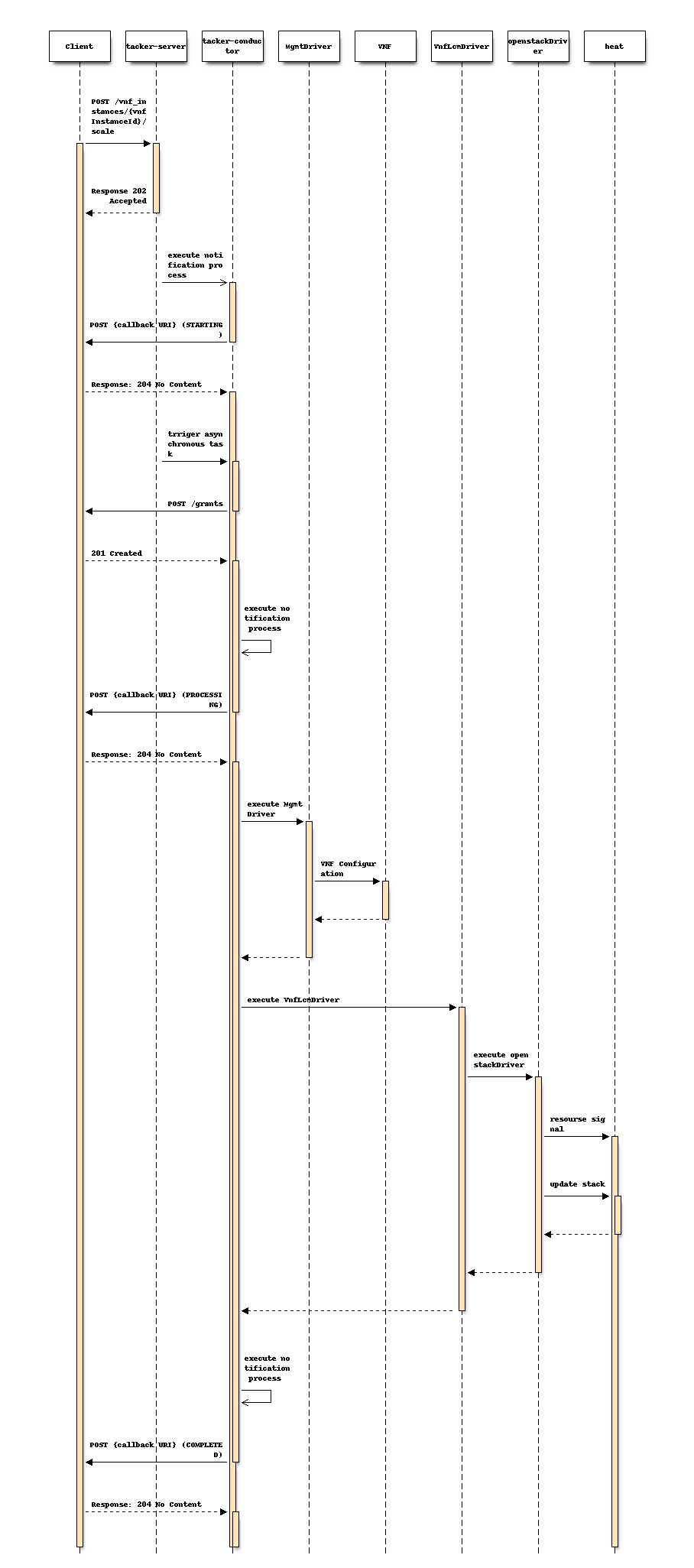Support scaling operations for VNF based on ETSI NFV-SOL specification¶
https://blueprints.launchpad.net/tacker/+spec/support-etsi-nfv-specs
ETSI specifications within the NFV Architecture Framework [1] describe the main aspects of NFV development and usage based on of the industry needs, feedback from SDN/NFV vendors and telecom operators. These specifications include the REST API and data model architecture which is used by NFV users and developers in related products.
Problem description¶
In the current Tacker implementation based on ETSI NFV-SOL, Tacker uses its own API which describes scaling operations which is Ability to dynamically extend/reduce resources granted to the Virtual Network Function (VNF) as needed.
However, these operations are not aligned with the current ETSI NFV data-model. As a result, there might be lack of compatibility with 3rd party VNFs [4], as they are developed according to ETSI NFV specifications. Support of key ETSI NFV specifications will significantly reduce efforts for Tacker integration into Telecom production networks and also will simplify further development and support of future standards.
Proposed change¶
Introduce a new interface to invoke VNF lifecycle management operations of VNF instances towards the VNFM. The operation provided through this interface is:
Scale VNF
1) Flow of Scale Out of a VNF instance¶
Precondition: VNF instance in INSTANTIATED state.

The procedure consists of the following steps as illustrated in above sequence:
Client sends a POST request to the Scale VNF Instance resource.
VNFM sends to the Client a VNF lifecycle management operation occurrence notification with the “STARTING” state to indicate the start occurrence of the lifecycle management operation.
VNFM and Client exchange granting information.
VNFM sends to the Client a VNF lifecycle management operation occurrence notification with the “PROCESSING” state to indicate the processing occurrence of the lifecycle management operation.
OpenstackDriver sends resource-signal request to Heat to scale out the resource. The number of VMs to scale out is calculated by multiplying “number_of_steps” contained in Scale VNF request and “number_of_instances” contained in VNFD.
OpenstackDriver sends request to Heat to update the stack, and the “desired_capacity”, contained in HOT of the target VM, is incremented. As a Heat specification, “desired_capacity” is referenced during UpdateStack, this process is performed so as to prevent returning to the previous number of VMs at the time of the next UpdateStack.
VNFM sends to the Client a VNF lifecycle management operation occurrence notification with the “COMPLETED” state to indicate the completion occurrence of the lifecycle management operation.
When scaling multiple VMs, resource-signal and Update Stack are repeated as a set for each VM.
Postcondition: VNF instance is still in INSTANTIATED state and VNF has been scaled.
2) Flow of Scale in of a VNF instance¶
Precondition: VNF instance in INSTANTIATED state.

The procedure consists of the following steps as illustrated in above sequence:
Client sends a POST request to the Scale VNF Instance resource.
VNFM sends to the Client a VNF lifecycle management operation occurrence notification with the “STARTING” state to indicate the start occurrence of the lifecycle management operation.
VNFM and Client exchange granting information.
VNFM sends to the Client a VNF lifecycle management operation occurrence notification with the “PROCESSING” state to indicate the processing occurrence of the lifecycle management operation.
OpenstackDriver sends resource-signal request to Heat to scale in the resource. The number of VMs to scale in is calculated by multiplying “number_of_steps” contained in Scale VNF request and “number_of_instances” contained in VNFD.
OpenstackDriver sends request to Heat to update the stack, and the “desired_capacity”, contained in HOT of the target VM, is decremented. As a Heat specification, “desired_capacity” is referenced during UpdateStack, this process is performed so as to prevent returning to the previous number of VMs at the time of the next UpdateStack.
VNFM sends to the Client a VNF lifecycle management operation occurrence notification with the “COMPLETED” state to indicate the completion occurence of the lifecycle management operation.
When scaling multiple VMs, resource-signal and Update Stack are repeated as a set for each VM.
When scale-in (resource-signal) is executed using Heat, Heat operates to delete the VM which was created at first. Depending on the VNF, it may be necessary to delete the VM that is last created . Therefore, it is possible to select the order of VM removal in ‘additionalParams’ as scaling request parameter. If isReverse in ‘additionalParams’ is True, delete from the last registered VM. If not, delete from first registered VM. If ‘additionalParams’ is not set, the behavior is the same as False.
Postcondition: VNF instance still in INSTANTIATED state and VNF has been scaled.
Alternatives¶
None
Data model impact¶
Modify following tables in current Tacker database. The corresponding schemas are detailed below:-
- vnf_instantiated_info::
scale_status scale_status json
- vnf_lcm_op_occs::
operation_params operation_params json
“operation_parames” stores additionalParams attribute of ScaleVNF Request. It is used for getting operation status from NFVO.
REST API impact¶
The following restFul API will be added. This restFul API will be based on ETSI NFV SOL002 [2] and SOL003 [3].
- Name: Scale VNF InstancesDescription: Scale by add/remove VNF instance resourcesMethod type: POSTURL for the resource: /vnflcm/v1/vnf_instances/{vnfInstanceId}/scaleRequest: Resource URI variables for this resource
Name
Description
vnfInstanceId
The identifier of the VNF instance to be scaled.
Request:Data type
Cardinality
Description
ScaleVnfRequest
1
Parameters for the Scale VNF operation.
Attribute name
Data type
Cardinality
Supported in (V)
type
Enum(inlined)
1
Yes
aspectId
IdentifierInVnfd
1
Yes
numberOfSteps
Integer
0..1
Yes
additionalParams
KeyValuePairs
0..1
Yes
Response:Data type
Cardinality
Response Codes
Description
n/a
n/a
Success 202Error 404 409The request was accepted for processing, but the processing has not been completed.
Security impact¶
None
Notifications impact¶
None
Other end user impact¶
Add new OSC commands in python-tackerclient to invoke scaling operations of VNF instances API.
Performance Impact¶
None
Other deployer impact¶
The previously created VNFs will not be allowed to be managed using the newly introduced APIs.
Developer impact¶
None
Implementation¶
Assignee(s)¶
- Primary assignee:
Keiko Kuriu <keiko.kuriu.wa@hco.ntt.co.jp>
Work Items¶
Add new REST API endpoints to Tacker-server for scaling operations of VNF instances.
Make changes in python-tackerclient to add new OSC commands for calling scaling operations of VNF instances restFul APIs.
Add new unit and functional tests.
Change API Tacker documentation.
Dependencies¶
None
Testing¶
Unit and functional test cases will be added for VNF lifecycle management of VNF instances.
Documentation Impact¶
Complete user guide will be added to explain how to invoke VNF lifecycle management of VNF instances with examples.
